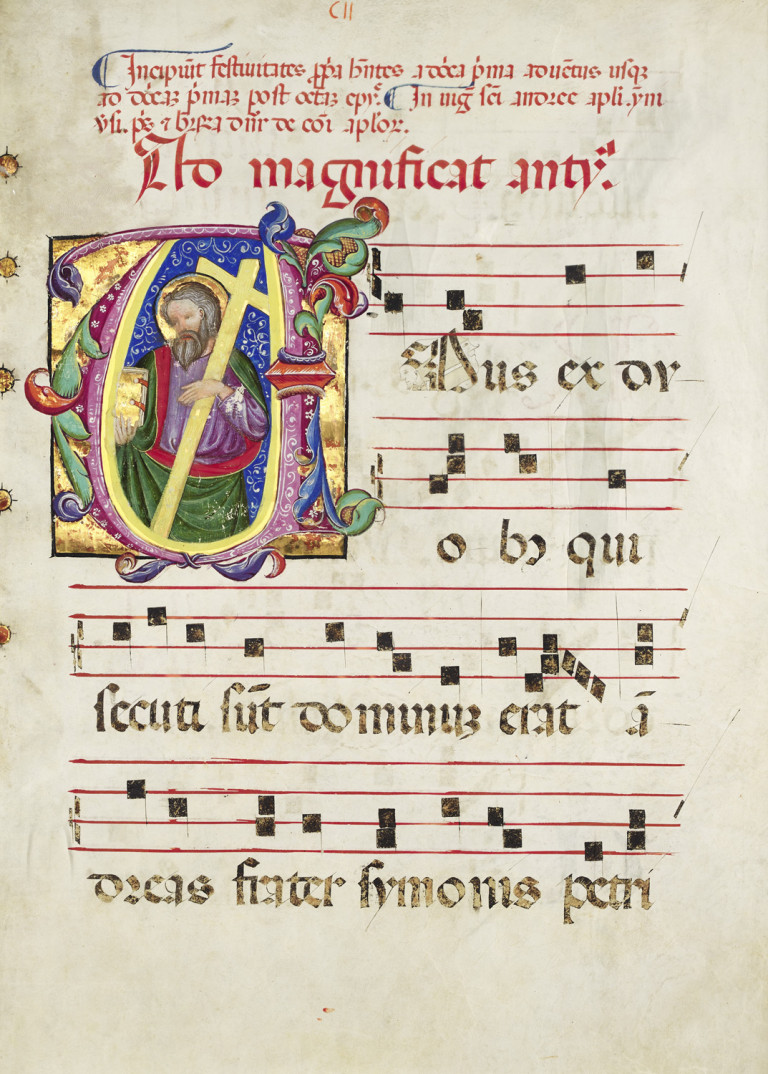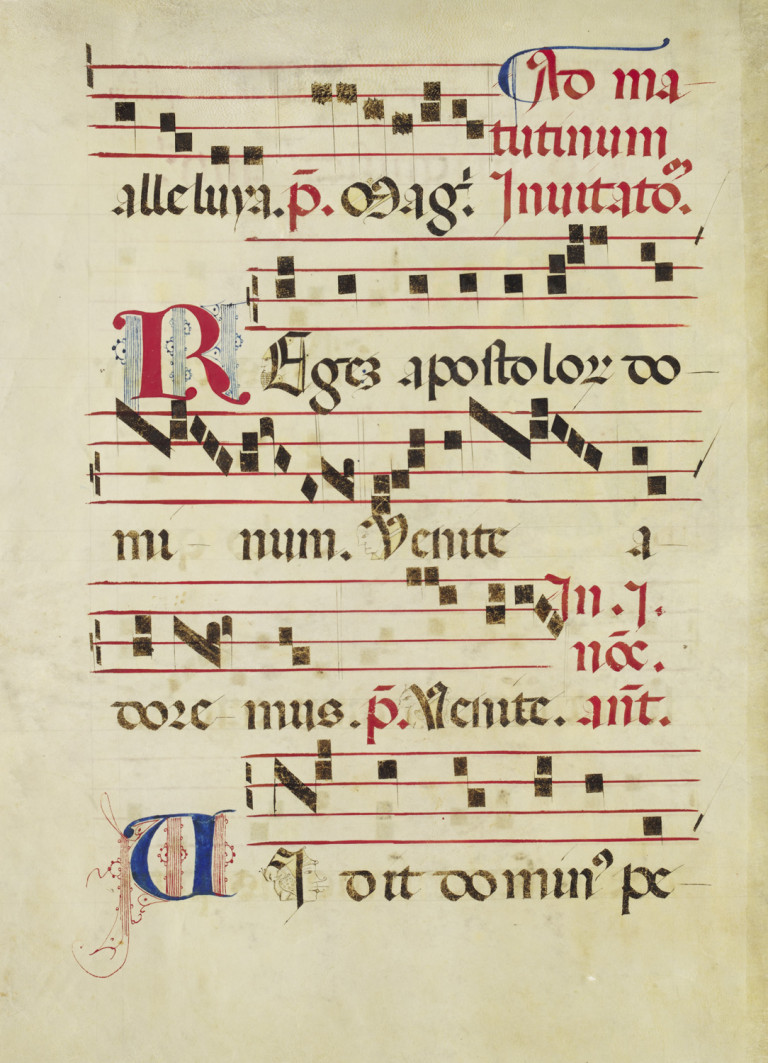Online Catalogue with all Lots / Auction 157
Rare Books, Prints, Historical Photography
Friday, 24 October 2025 at 11:00 am Lose 1- 1105
Saturday, 25 October 2025 at 11:00 am Lose 1106-2003 - After sale
Lot 195 Magnificat. Prachtvolles …
Magnificat. Prachtvolles gotisches Choralblatt mit dem heiligen Andreas. Antiphonar. 22 (recto) bzw. 26 (verso) Zeilen. Gotische Textura. Quadratnotation auf Vierliniensystem. Verso mit drei Federwerkinitialen in Rot- und Blau. 51,3 x 37,5 cm (Lichtes Maß). Schriftraum 40x29 cm. Süddeutschland oder Österreich. 15. Jahrhundert.
Mittelalter - Renaissance
Manuskripte und Urkunden – Zur Graphologie: Das Textbild zeigt eine kalligraphisch regelmäßige gotische Textura mit ausgeprägten Versalien und sorgsam gestalteten Buchstaben. Die Abschnittsüberschriften und der Anfangssatz ("Ho magnificat" etc.) sind in roter und schwarzer Tinte ausgeführt (Rubrizierung), typisch für liturgische Handschriften des 15. Jahrhunderts. Die Notenzeilen und Quadratnotation legen einen klösterlich-choralischen Kontext nahe, wobei die Klarheit der Buchstaben und Noten für professionelle Buchmalerarbeit spricht. Zur Paläographie: Die Schrift entspricht der gotischen Textualis (Formata) des 15. Jahrhunderts, typisch für Musikhandschriften in Mitteleuropa. Die Rubrizierung, Lombarden und besonders ausgearbeitete Versalien entsprechen einer Hierarchie im liturgischen Text. Die Musiknotation ist eine Quadratnotation auf Vierliniensystem, die ab ca. 1250 erstmals vor allem in Italien, Burgund, Bayern und Österreich sichtbar wird und im gesamten deutschen Kulturraum spätestens ab dem 14. Jahrhundert bis ins 16. Jahrhundert den Choral bestimmt. Inhalt: Der Text mit dem Andreas Antiphon: "Unus ex duobus qui secuti sunt dominum erat Andreas frater Simonis Petri alleluia". - Die historisierte Initiale "U" mit dem Heiligen Andreas als Kreuzträger illustriert auf Goldgrund. Charakteristisch sind leuchtende, satte Farben (Blau, Purpur, Rot, sattem Grün, Goldauflagen), wie auch vegetabile Ranken, typisch für spätgotische österreichische und süddeutsche Buchmalerei des 15. Jahrhunderts. - Die Art der Binnenminiatur (menschliche Figur im U) mit Faltenwurf, Feingoldauflagen und ornamentalem Rankenbesatz ist besonders typisch für Werkstätten in Bayern, Salzburg, Niederösterreich und Süddeutschland (u.a. Augsburg) um 1450-1500. - Stilistisch verweisen Details wie die plastische Modellierung der Figur, die Verwendung von schimmernden Goldhintergründen und vegetabile Besatzteile auf größere Werkstätten wie sie für die Chorhandschriften bedeutender Klöster, etwa Kremsmünster, Regensburg (St. Emmeram), Altenhohenau oder das Umfeld Münchens, nachgewiesen sind.
Manuscripts – Magnificent Gothic choral sheet with St. Andrew. 22 (recto) and 26 (verso) lines. Square notation on a four-line system. Verso with three pen-and-ink initials in red and blue. Southern Germany or Austria. 15th century. On graphology: The text shows a calligraphically regular Gothic textura with pronounced capital letters and carefully designed letters. The section headings and the opening sentence ("Ho magnificat" etc.) are written in red and black ink (rubrication), typical of liturgical manuscripts of the 15th century. The staves and square notation suggest a monastic choral context, while the clarity of the letters and notes indicates professional illumination work. On paleography: The script corresponds to the Gothic Textualis (Formata) of the 15th century, typical of music manuscripts in Central Europe. The rubrication, Lombardic letters, and specially crafted capital letters correspond to a hierarchy in the liturgical text. The musical notation is a square notation on a four-line system, which first appeared around 1250, mainly in Italy, Burgundy, Bavaria, and Austria, and dominated choral music throughout the German cultural area from the 14th century at the latest until the 16th century. Content: The text with the Andreas Antiphon: "Unus ex duobus qui secuti sunt dominum erat Andreas frater Simonis Petri alleluia". - The historicized initial "U" with St. Andrew as the cross-bearer illustrated on a gold background. Characteristic are bright, rich colors (blue, purple, red, rich green, gold overlays), as well as vegetal tendrils, typical of late Gothic Austrian and southern German book illumination of the 15th century.- The type of internal miniature (human figure in the U) with drapery, fine gold plating, and ornamental tendrils is particularly typical of workshops in Bavaria, Salzburg, Lower Austria, and southern Germany (including Augsburg) around 1450-1500.- Stylistically, details such as the sculptural modeling of the figure, the use of shimmering gold backgrounds, and vegetal trimmings point to larger workshops such as those documented for the choir manuscripts of important monasteries, for example, Kremsmünster, Regensburg (St. Emmeram), Altenhohenau, or the Munich area.
Post Auction Price: 2500 €
Premium and taxation
This work is subject to under the regular margin scheme. There is a 24.95% buyer's premium on the hammer price and inside the EU 7% (Books, Paintings, Drawings and most Prints) and 19% (Photographs, Screen and Offsetprints, Autographs and Manuscripts) VAT on the final invoice amount.
Shipping
A pickup of this work is possible in our premises at Potsdamer Str. 16, 14163 Berlin by appointment. If you wish a shipment of the work, please contact us for a consultation and shipping calculation.
Terms and Conditions
You can view our terms and conditions here
Droit de Suite
On the sales proceeds of all original works of fine art and photography, whose authors have not yet died 70 years before the end of the sale, an additional 2% (subject to change) of the hammer prices from 400€ will be charged pro rata for the VG Bild-Kunst, which represents the copyrights of visual artists according to § 26 UrhG.
Submit a bid
I would like to participate in your auction by accepting the General Terms and Conditions of Jeschke van Vliet Auctions Berlin GmbH.

